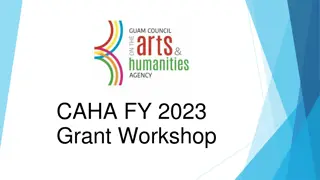Enhancing Evaluation and Impact in Arts and Humanities
Redesigning self-evaluation reports to prioritize analysis, addressing challenges in evaluating scientific impact, defining societal impact, improving completion rates for doctoral programs, and enhancing academic leadership in arts and humanities institutions.
Uploaded on Sep 15, 2024 | 0 Views
Download Presentation

Please find below an Image/Link to download the presentation.
The content on the website is provided AS IS for your information and personal use only. It may not be sold, licensed, or shared on other websites without obtaining consent from the author.If you encounter any issues during the download, it is possible that the publisher has removed the file from their server.
You are allowed to download the files provided on this website for personal or commercial use, subject to the condition that they are used lawfully. All files are the property of their respective owners.
The content on the website is provided AS IS for your information and personal use only. It may not be sold, licensed, or shared on other websites without obtaining consent from the author.
E N D
Presentation Transcript
Arts and Humanities: General Suggestions Peter Jonkers (Tilburg University)
1. Self-Evaluation The self-evaluation report should be redesigned in order to prioritise analysis over description. The employment of descriptors such as add facts is counterproductive and tends to lead to an emphasis on product over process throughout. The inclusion of a final section on strategic forward planning would be a more coherent summation of the self-evaluation exercise, while also providing continuity from one evaluation exercise to another.
2. Evaluation of Scientific Impact The panel has encountered wide-spread problems concerning the evaluation of publications in the humanities. The academic community of arts and humanities clearly lacks confidence in the criteria for scientific impact as presently formulated. What is needed for a more equitable and effective evaluation is: (i) Appropriate credit should be given for research undertaken in the production of monographs, the editing of and contributions to multi-authored work. (ii) The evaluation system should take account of the scientific quality of a publication irrespective of the language in which it is written. A multi-lingual system of evaluation is a matter of balancing three variables: (1) the scope (2) the subject and (3) audience. (iii) The current system fails to capture the range of research and the various modes in which it is produced. This is particularly evident in the absence of criteria for non-text based research [ artistic , practice- based ]. A bench-marking exercise against other European models would be useful.
3. Societal Impact The academic community requires a more lucid definition of what is understood by societal impact; this should be substantiated by exemplars drawn from a much broader range of domains than the impact of research on the economy. It is clear that enterprise and entrepreneurial approaches do not appear to be at the forefront of most institutions visited. There is also a need to outline the relationship between scientific and societal impact for research in these fields such that the criteria may provide an appropriate and effective framework for quality assessment of the research.
4. Doctoral Programmes While the research base for doctoral programmes is generally satisfactory, there are widespread issues around completion rates that are linked to extremely low funding levels. The current provision in Estonian is out of line with other European countries. Many students are by necessity in full-time employment, and carrying out their doctoral research part-time.
5. Academic Leadership There is a lack of strategic leadership in (almost) all institutions. In many cases, the dean of the faculty or the director of a non-university research institute have a clear vision about the future of their unit, but are not successful in conveying it to the heads of department and the (senior) researchers. Therefore appropriate professional training and development in strategic management for researchers at various stages of their career is necessary.























